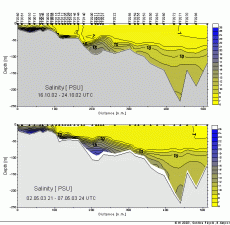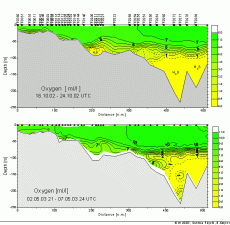

Baltic inflow of January 2003
Kattegat waters intruded into the Baltic in January, 2003
Autonomous measuring platforms located at the Darss Sill, the main entrance to the Baltic Sea deeper basins, and in the Arkona Basin recorded an inflow of highly saline, cold and extremly oxygen-rich water from the North Sea between January 16th and 25th, 2003. At the Darss Sill, surface salinities exceeding 17 PSU were measured from 18th till 23rd. The inflow could be observed on-line because data are transmitted directly via satellite to the Baltic Sea Research Institute in Warnemünde (IOW) and to the Federal Martime and Hydrographic Agency in Hamburg (BSH). In parallel to the inflow through the Belts, the Swedish Meteorological and Hydrographical Institute (SMHI) had measured the inflow through the Sound.
The reason for this unusual event was the rather low water level (20-30 cm below normal at Stockholm; level data courtesy SMHI) in the Baltic Sea due to a stable high pressure cell over Scandinavia and the associated north-easterly winds. After the wind over the Western Baltic had turned to gale strength (15 m/s, wind data courtesy Deutscher Wetterdienst, DWD) from westerly directions on January, 11th, the Western Baltic sea level suddenly lowered to even -80 cm and a strong inflow commenced. The intrusion continued with heavy fluctuations until the wind began fading on the 18th, leaving the Stockholm level risen to 25 cm above normal. North Sea water started to propagate over the sills into the deeper basins with a delay of a few days. This slower process was further supported by southerly winds continuously blowing until the 24th, thus allowing the heavy waters piled up the shallow Western Baltic to further flow eastward and preventing them to be immediately washed out again into the Kattegat.
Triggered by these exceptional observations made at the measuring platforms, an ad-hoc expedition with the research vessel „Professor Albrecht Penck“ was performed from 24th until 26th by IOW in order to trace the actual spatial and temporal distribution of the water masses. The area under investigation covered the Baltic Sea between the Mecklenburg Bight and the Bornholm Basin. Focus was laid on hydrographical measurements accompanied by numerous oxygen determinations. The inflowing water had reached the Arkona Basin where it formed a 10 m thick saline layer at the bottom along a section through the centre of the basin. This water was well enriched with oxygen (around 8 ml/l).
In the Bornholmsgat highly saline water was observed with up to 24.5 PSU near to the bottom, indicating the contribution of inflowing water via the Sound. The effects of the inflow could be found already in the Bornholm Basin, too. In the western part the whole water column was well oxygenated with 6.69 ml/l near to the bottom. The salinity measured there was 18.7 PSU. Also at the central station in the Bornholm Basin (BY 5) the first signs of the inflow could be detected. An oxygen-poor layer was lifted up by new inflowing water which had at 87 m depth 16.2 PSU and 2.98 ml/l oxygen at 87 m depth.
Such inflows of heavy oxygen-rich water are the only possibility to renew the deep water in the central basins of the Baltic Sea and to improve the oxygen situation there. Therefore, these events are welcomed by scientists and fishermen as well. The last major inflow took place in 1993/1994. Since then, the waters in the deeper basins were stagnating and the formation of considerable amounts of toxic hydrogen sulphide occurred. Even though the medium inflow of September 1997 had replaced the deep layers by exceptionally warm waters, it did not lastingly better their poor ventilation status.
By now it can only be estimated how large the current inflow amounts for. The Swedish research vessel „Argos“ reported an inflow of 40 km3 through the Sound which is normally around one third of the total inflow through both the Sound and the Belt Sea. Thus, about 120 km3 may have entered the Baltic Sea. Calculations using the sea level difference of about 50 cm at the Landsort gauge yield an estimate of 180 km3. The present inflow may be evaluated as the most important event since 1993/1994 because of its magnitude and especially its oxygen-saturated, heavy hibernal waters. Since its volume (prior to mixing) is smaller than the 225 km3 of the Bornholm Basin below the sill of the Stolpe Channel, the salt water inflow is expected to lift up the stagnating bottom water of the Bornholm Basin. Subsequently, this old bottom water will likely proceed through the Stolpe Channel into the Gotland basin. At present one cannot predict how much mixing will occur in the Stolpe Channel between the uplifted old bottom water and that of the recent inflow.
Upcoming regular monitoring cruises in Febraury and March have to investigate the further propagation of the inflowing water and its possible effects on the eastern Gotland Basin. Only then, the inflow can be finally evaluated.
Authors: Dr. Rainer Feistel, Dr. Hans Ulrich Lass, Dr. Günther Nausch, Baltic Sea Research Institute Warnemünde January 29th, 2003
Documented Major Baltic Inflows
Downloads
Figures


